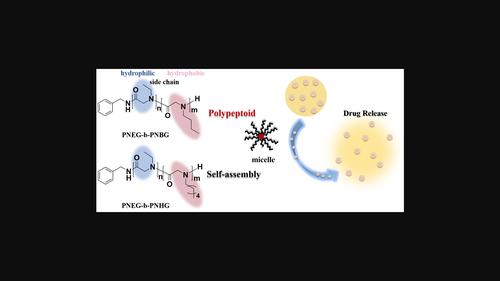Self-assembled polypeptoid micelles from amphiphilic polypeptoid copolymers for drug delivery
Xiran Shen, Tiantian Wei, Di Liu, Kang Yang, Yangang Jiang, Jianwei Lu, Li Guo
求助PDF
{"title":"Self-assembled polypeptoid micelles from amphiphilic polypeptoid copolymers for drug delivery","authors":"Xiran Shen, Tiantian Wei, Di Liu, Kang Yang, Yangang Jiang, Jianwei Lu, Li Guo","doi":"10.1002/pi.6635","DOIUrl":null,"url":null,"abstract":"<p>Amphiphilic block copolymers are characterized by the presence of distinct hydrophilic and hydrophobic regions, which are usually arranged in alternating blocks. This unique structure allows these copolymers to self-assemble into well-defined nanostructures that exhibit remarkable resistance to enzymatic hydrolysis, high biocompatibility and the ability to be customized with specific structures. These properties make them highly desirable in various applications. Self-assembled amphiphilic polypeptoids are currently under development as a promising class of pharmaceutical agents. However, the utilization of these peptides as drug carriers for efficient delivery presents a number of challenges. These challenges include less-than-optimal loading efficacy and restricted biocompatibility. Herein, a series of stable amphiphilic block copolypeptoids (PNEG-b-PNBG and PNEG-b-PNHG) were designed and synthesized by controlled ring-opening polymerization. PNEG chain segments provide hydrophilicity, while PNBG and PNHG chain segments provide hydrophobicity. The hydrophobic molecular chains aggregate in aqueous solutions, resulting in the formation of nano-assemblies. The self-assembled amphiphilic block polypeptoid copolymers were investigated. The morphologies of copolymers take the form of micelles from tens of nanometers to a few hundred nanometers. The properties of amphiphilic block copolypeptoids used as drug carriers were further investigated by conducting drug release and cytotoxicity tests. The results indicate that the cumulative release efficiency of self-assembled polypeptoid copolymers can reach up to about 91%. And they have good biocompatibility and can be expected to be safe materials for efficient drug delivery. This work could provide a facile method for the preparation of amphiphilic block peptoid copolymers for biopharmaceutical applications. © 2024 Society of Industrial Chemistry.</p>","PeriodicalId":20404,"journal":{"name":"Polymer International","volume":"73 8","pages":"639-645"},"PeriodicalIF":2.9000,"publicationDate":"2024-03-30","publicationTypes":"Journal Article","fieldsOfStudy":null,"isOpenAccess":false,"openAccessPdf":"","citationCount":"0","resultStr":null,"platform":"Semanticscholar","paperid":null,"PeriodicalName":"Polymer International","FirstCategoryId":"92","ListUrlMain":"https://onlinelibrary.wiley.com/doi/10.1002/pi.6635","RegionNum":4,"RegionCategory":"化学","ArticlePicture":[],"TitleCN":null,"AbstractTextCN":null,"PMCID":null,"EPubDate":"","PubModel":"","JCR":"Q2","JCRName":"POLYMER SCIENCE","Score":null,"Total":0}
引用次数: 0
引用
批量引用
Abstract
Amphiphilic block copolymers are characterized by the presence of distinct hydrophilic and hydrophobic regions, which are usually arranged in alternating blocks. This unique structure allows these copolymers to self-assemble into well-defined nanostructures that exhibit remarkable resistance to enzymatic hydrolysis, high biocompatibility and the ability to be customized with specific structures. These properties make them highly desirable in various applications. Self-assembled amphiphilic polypeptoids are currently under development as a promising class of pharmaceutical agents. However, the utilization of these peptides as drug carriers for efficient delivery presents a number of challenges. These challenges include less-than-optimal loading efficacy and restricted biocompatibility. Herein, a series of stable amphiphilic block copolypeptoids (PNEG-b-PNBG and PNEG-b-PNHG) were designed and synthesized by controlled ring-opening polymerization. PNEG chain segments provide hydrophilicity, while PNBG and PNHG chain segments provide hydrophobicity. The hydrophobic molecular chains aggregate in aqueous solutions, resulting in the formation of nano-assemblies. The self-assembled amphiphilic block polypeptoid copolymers were investigated. The morphologies of copolymers take the form of micelles from tens of nanometers to a few hundred nanometers. The properties of amphiphilic block copolypeptoids used as drug carriers were further investigated by conducting drug release and cytotoxicity tests. The results indicate that the cumulative release efficiency of self-assembled polypeptoid copolymers can reach up to about 91%. And they have good biocompatibility and can be expected to be safe materials for efficient drug delivery. This work could provide a facile method for the preparation of amphiphilic block peptoid copolymers for biopharmaceutical applications. © 2024 Society of Industrial Chemistry.
用于药物输送的两亲性多肽共聚物自组装胶束
两亲嵌段共聚物的特点是存在明显的亲水和疏水区域,这些区域通常以交替嵌段的方式排列。这种独特的结构使这些共聚物能够自组装成定义明确的纳米结构,具有显著的抗酶水解性、高生物相容性和定制特定结构的能力。这些特性使它们在各种应用中备受青睐。自组装两亲多肽目前正作为一类有前途的药物进行开发。然而,利用这些多肽作为药物载体进行高效递送面临着许多挑战。这些挑战包括装载效果不理想和生物相容性受限。在此,我们设计并通过受控开环聚合(ROP)合成了一系列稳定的两亲嵌段共聚多肽(PNEG-b-PNBG 和 PNEG-b-PNHG)。PNEG 链段具有亲水性,而 PNBG 和 PNHG 链段具有疏水性。疏水性分子链在水溶液中聚合,形成纳米组合体。对自组装的两亲嵌段多肽共聚物进行了研究,共聚物的形态为几百纳米的胶束和几十纳米的胶束。通过药物释放和细胞毒性测试,进一步研究了用作药物载体的两亲嵌段共聚多肽的特性。结果表明,自组装多肽共聚物的累积释放效率可达 91%左右。而且它们具有良好的生物相容性,有望成为高效给药的安全材料。这项工作为制备生物制药应用中的两亲嵌段肽类共聚物提供了一种简便的方法。本文受版权保护。
本文章由计算机程序翻译,如有差异,请以英文原文为准。



